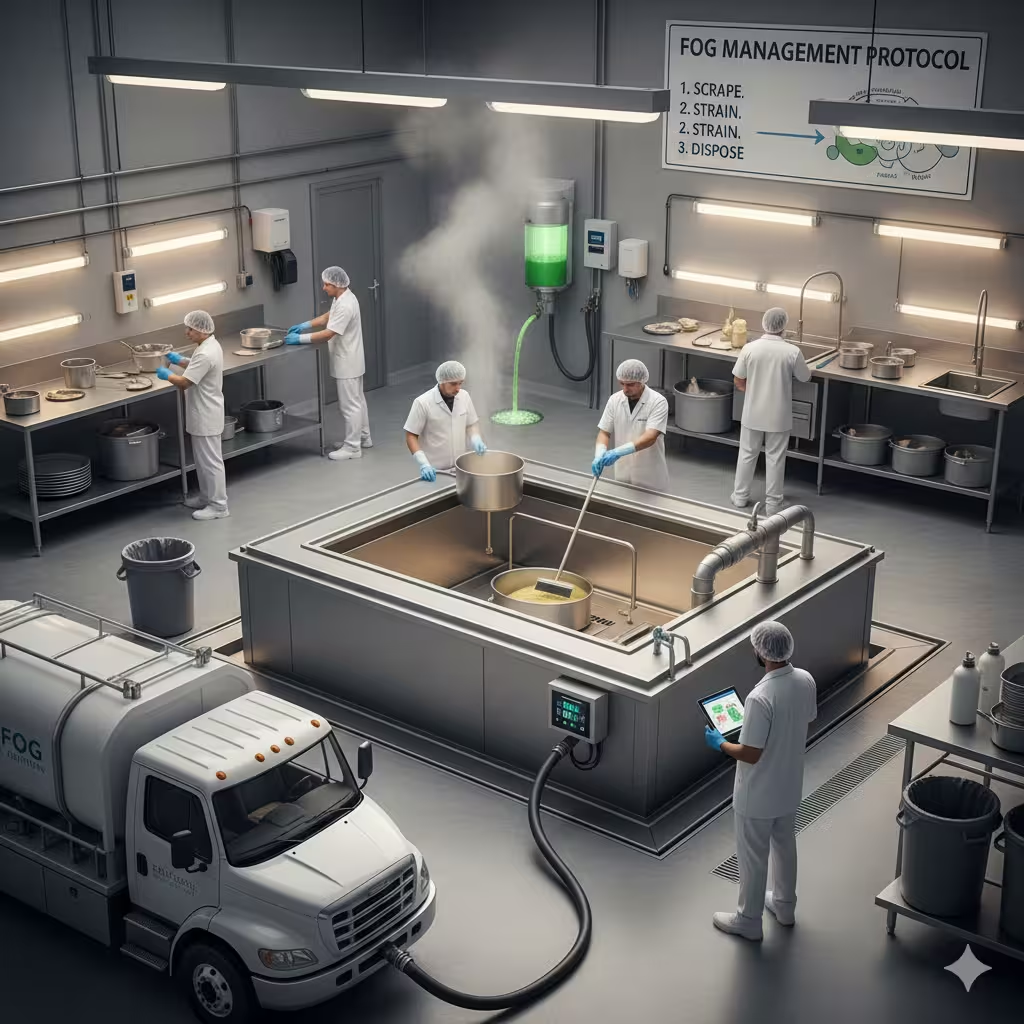This comprehensive guide breaks down everything you need to know about setting up, maintaining, and achieving compliance with a high-performance Commercial FOG Management program.
1. Understanding the FOG Crisis: Why It Matters to Your Business
FOG is a natural byproduct of food preparation, cooking, and dishwashing in any Food Service Establishment (FSE), including restaurants, hotels, hospitals, and food processing plants. When poured down the drain, liquid FOG cools rapidly and solidifies, adhering to the interior walls of your plumbing and the municipal sewer system.
The Real Cost of Neglecting FOG Control
| Impact Area | Consequences of Poor FOG Management |
| Operational | Clogged drains, slow flow, wastewater backups, and unsanitary conditions. |
| Financial | Expensive emergency plumbing repairs, increased grease trap pumping fees, and higher maintenance costs. |
| Legal & Compliance | Significant fines and legal action from local municipalities and water authorities for Sanitary Sewer Overflows (SSOs). |
| Environmental | Contamination of local waterways, soil, and potential public health risks. |
Your business is legally obligated to prevent FOG from leaving your property and entering the public sewer. Therefore, robust Commercial FOG Management is the foundation of operational integrity.
2. Grease Control Devices: Traps vs. Interceptors
The first line of defense in an effective Commercial FOG Management strategy is the installation of an appropriately sized and maintained grease control device. These devices separate and retain FOG from wastewater before it enters the sewer system.
A. Hydro-Mechanical Grease Traps (HGTs)
Often called “grease traps,” these are smaller units, typically located under-sink or inside the facility.
- Capacity: Typically 10 to 100 gallons.
- Best for: Low-volume food service, smaller cafes, or areas with limited space (e.g., dishwashing stations).
- Maintenance: Require frequent—often daily or weekly—cleaning by staff due to their small volume.
B. Gravity Grease Interceptors (GGIs)
Often simply called “grease interceptors,” these are large, in-ground tanks. They use the natural process of gravity and retention time to separate the less-dense FOG from the denser water.
- Capacity: Typically 750 gallons or larger.
- Best for: High-volume FSEs, large industrial kitchens, food manufacturers, and facilities with high flow rates.
- Maintenance: Require professional pump-outs on a less frequent schedule (typically 90 days or less), determined by the 25% Rule (see Section 4).
Grease Interceptor Sizing is critical. An undersized unit will fail to perform, leading to immediate non-compliance, regardless of how often you clean it. Always consult an expert to determine the correct sizing based on peak flow, kitchen type, and menu.
3. Best Management Practices (BMPs) for FOG
Compliance begins on the kitchen floor. Best Management Practices (BMPs) are procedural controls that significantly reduce the amount of FOG entering your drainage system, which is a key component of effective Commercial FOG Management.
Source Control Strategies
- Dry Wipe First: Before washing pots, pans, plates, or utensils, use a rubber scraper or paper towel to wipe off residual grease and food scraps into a solid waste bin. This is the single most important step.
- Eliminate Garbage Disposals: Grinding food scraps introduces high-solids waste directly into your drain line, accelerating the fill rate of your grease control device and reducing its efficiency.
- Use Sink Strainers: Ensure all sinks have fine-mesh strainers to capture any remaining solid food particles.
- Dedicated FOG Disposal: All used cooking oil, fryer grease, and deep fryer fat must be collected in sealed, clearly marked rendering barrels for recycling by a licensed waste hauler. Never pour cooking oil down the drain.
Staff FOG Training is essential. Regularly conduct training for all kitchen personnel (using translated signs if necessary) to enforce BMPs and ensure everyone understands their role in Commercial FOG Management.

4. Achieving and Maintaining FOG Compliance
Local, state, and national regulations are increasingly stringent regarding FOG discharge. Non-compliance is expensive and easily avoidable with a structured Commercial FOG Management program.
The 25% Rule and Pumping Frequency
Most jurisdictions enforce the 25% Rule, which is the most common standard for pump-out frequency.
- Rule: A grease interceptor or trap must be cleaned out when the total volume of FOG (the scum layer) and settled solids (the sludge layer) displaces more than 25% of the total operating capacity of the interceptor.
- Action: For high-volume establishments, this typically necessitates a professional pump-out every 30 to 90 days. Waiting until the trap is full is already a violation.
The Prohibition on Additives and Emulsifiers
A common misconception is that using hot water, degreasers, or chemical solvents will solve a FOG problem. This is entirely false and often prohibited by municipal codes.
- The Problem: These substances only emulsify or liquefy the grease temporarily. The FOG then bypasses the grease trap and re-solidifies downstream in the public sewer system, causing a much larger and more costly blockage that can be traced back to your facility.
- The Solution: Instead, opt for plant-based natural FOG solutions that use specialized, eco-friendly microbes and enzymes. These products are designed to biologically digest the FOG into water-soluble compounds like carbon dioxide and water, preventing it from re-congealing. This approach is a cornerstone of modern, sustainable Commercial FOG Management.
Record Keeping: Your Defense Against Fines
Every FSE is required to maintain a FOG logbook or digital records. These documents prove your due diligence and compliance.
- Required Documentation:
- Grease interceptor pump-out manifests/receipts from licensed haulers.
- Daily or weekly in-house cleaning logs for under-sink grease traps.
- Staff FOG training sign-off sheets.
- Records of FOG removal device inspection and repairs.
5. Industrial FOG Management: Unique Challenges
While restaurants are the primary focus of Commercial FOG Management, industrial operations—such as large-scale food manufacturing, meat processing, and centralized commissaries—face unique, high-volume challenges.
- Higher Flow Rates: Industrial facilities generate massive volumes of wastewater and FOG, necessitating much larger gravity grease interceptors (potentially thousands of gallons).
- Pretreatment Systems: Many industrial facilities are required to install complex wastewater pretreatment systems to ensure their discharge meets specific effluent limitations (e.g., FOG concentration must be below 100 mg/L in some regions) before it enters the municipal system.
- Diverse Waste Stream: The waste often includes high levels of protein, oil, and solids, demanding specialized industrial FOG control technology beyond simple passive interceptors. This requires a dedicated Commercial FOG Management expert for system design and monitoring.
For industrial clients, highlight solutions like Dewatering and Solids Removal systems, which address the complex waste stream before it hits the main interceptor. A robust Commercial FOG Management strategy here involves engineering, not just maintenance.
6. Case Study: The Impact of Proactive FOG Control
A regional chain of large-scale commercial bakeries was struggling with monthly emergency calls due to sewer line blockages. Their traditional grease trap maintenance was reactive—they only called for a pump-out after a blockage occurred.
Before FOG Control Solutions:
- Maintenance: $8,000 in emergency plumbing and cleanup costs per quarter.
- Compliance: Two municipal fines issued in one year.
- Operational: Frequent downtime and foul odors.
After Implementing a Proactive Commercial FOG Management Program:
- Solution: A detailed audit led to the installation of larger, correctly sized grease interceptors and the implementation of a proprietary, timed biological treatment program.
- Maintenance: Quarterly preventative pump-outs replaced all emergency calls, reducing overall costs by 60%.
- Compliance: Fines were eliminated, and their FOG logs easily passed all municipal inspections.
This demonstrates that Commercial FOG Management is an investment that yields substantial ROI and peace of mind.
7. Frequently Asked Questions (FAQ) about FOG Compliance
People commonly search for clear, actionable answers to their FOG compliance questions. Here are the most critical ones:
Q1: Do I really need a grease trap if I don’t use deep fryers?
A: Yes. FOG comes from all cooked foods, including dairy products, salad dressings, sauces, gravy, baked goods, and even the natural oils in meat and fish. If you prepare food, you are generating FOG and require a grease control device and a Commercial FOG Management plan to prevent it from entering the sewer system.
Q2: How often should I pump my grease interceptor?
A: The standard minimum is typically every 90 days, but your specific frequency must comply with the 25% Rule. If the floating grease layer and the settled solids layer collectively take up more than 25% of your interceptor’s liquid depth, it needs to be pumped immediately, regardless of the time passed.
Q3: What is the biggest mistake businesses make with FOG control?
A: The biggest mistake is treating FOG control as a reactive emergency problem rather than a proactive management system. Waiting for a blockage to occur is the most expensive and legally risky approach. Consistent Commercial FOG Management through proper BMPs and scheduled maintenance is essential.
Q4: Will hot water or bleach clear a FOG blockage?
A: No, absolutely not. Hot water and bleach are often prohibited because they only push the liquefied grease further down the pipe where it cools and re-solidifies, creating blockages in the public sewer system. This is a common violation of Commercial FOG Management regulations.
Q5: Can I clean my own grease interceptor?
A: While you can clean a small, under-sink grease trap, large in-ground grease interceptors must be serviced by a licensed waste hauling contractor. You must obtain a manifest receipt from the contractor as proof of proper disposal to satisfy your compliance requirements.
Final Thoughts
Effective Commercial FOG Management is the difference between smooth operations and costly failures. It’s a continuous process that requires the right equipment, consistent maintenance protocols, and a deep understanding of municipal regulations. From small restaurant kitchens to large industrial facilities, a well-executed plan protects your property, ensures legal compliance, and contributes to a healthier environment.
If your current system is failing the 25% rule, if you’ve faced fines, or if you simply want to move to a sustainable, worry-free solution, it’s time to partner with experts. FOG Control Solutions is a reliable and trusted provider dedicated to delivering cutting-edge, plant-based, and highly effective Commercial FOG Management programs tailored to your unique operational needs.
✅ Ready to Stop FOG Blockages and Achieve 100% Compliance?
Book a consultation with FOG Control Solutions today to get a detailed audit of your current system and learn how our comprehensive, plant-based solutions can optimize your Commercial FOG Management strategy, eliminate headaches, and secure your long-term operational health.

